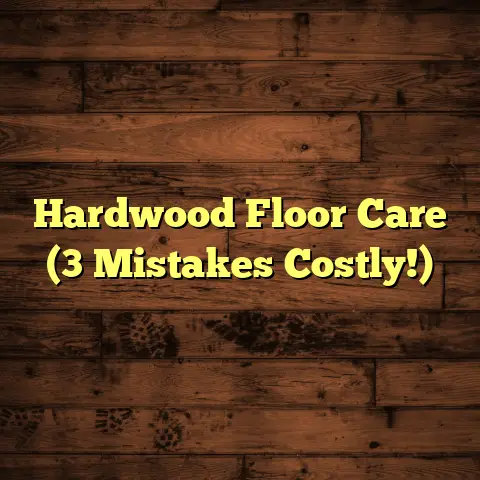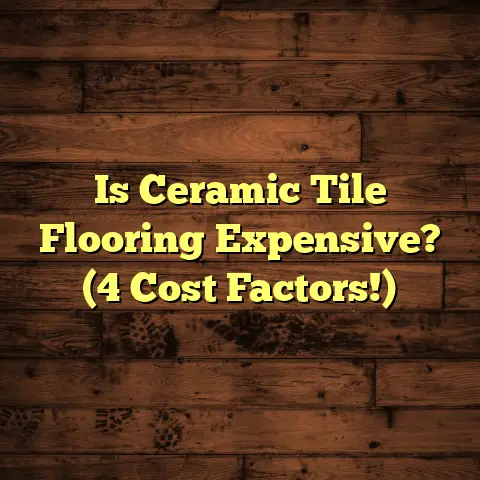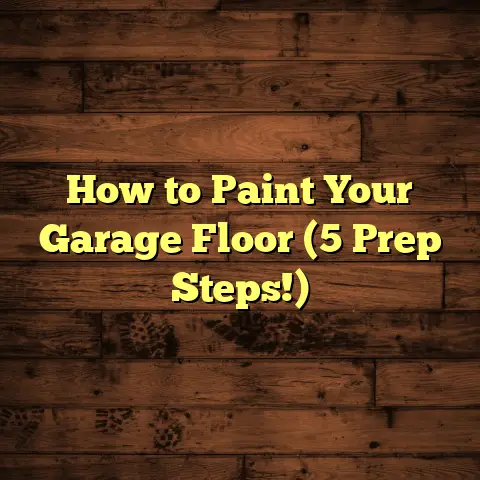Best Outdoor Flooring? (5 Weatherproof Options!)
As a flooring contractor for over 15 years, I’ve seen firsthand how the right outdoor flooring can transform a simple patio into a stunning oasis.
It’s an art, really.
A blend of technical skill, material knowledge, and a keen eye for design.
Think about it: We’re not just laying down planks or tiles.
We’re creating a foundation that has to withstand Mother Nature’s mood swings while looking fantastic doing it.
I’ve spent countless hours meticulously placing stones, ensuring perfect alignment, and sealing surfaces to protect against the elements.
It’s about that commitment to quality, that attention to detail, that makes all the difference.
The goal?
To craft outdoor spaces that are not only beautiful but also durable and long-lasting.
So, let’s dive into the world of weatherproof outdoor flooring and discover how to marry functionality with breathtaking aesthetics!
Section 1: The Importance of Weatherproof Flooring
Why is weatherproof flooring so crucial for your outdoor spaces?
Well, imagine investing in a beautiful patio, only to watch it crumble and fade after just a few seasons.
Heartbreaking, right?
Outdoor flooring faces a barrage of challenges:
- Rain and Snow: Moisture can seep into porous materials, leading to cracks and deterioration.
- UV Exposure: The sun’s harsh rays can fade colors and weaken surfaces.
- Temperature Fluctuations: Freezing and thawing cycles can cause materials to expand and contract, leading to structural damage.
I’ve seen decks warp, tiles crack, and pavers sink because the wrong materials were chosen.
But, the good news?
The right flooring can transform your outdoor living experience.
Think about it:
- Safety: Weatherproof flooring often offers better slip resistance, reducing the risk of falls.
- Longevity: Durable materials last longer, saving you money on replacements and repairs.
- Aesthetics: Quality flooring maintains its beauty, enhancing the overall look and feel of your outdoor space.
According to a recent study by the American Society of Landscape Architects (ASLA), homeowners are increasingly prioritizing durable, low-maintenance outdoor materials.
Investing in weatherproof flooring is not just about aesthetics; it’s about ensuring your outdoor space remains safe, beautiful, and functional for years to come.
Section 2: Overview of the Top 5 Weatherproof Outdoor Flooring Options
Alright, let’s get down to brass tacks.
Over the years, I’ve worked with a ton of different materials.
Through trial and error, I’ve narrowed down the list to my top five weatherproof outdoor flooring options.
Subsection 1: Composite Decking
Material Description: Composite decking is a fantastic alternative to traditional wood.
It’s typically made from a blend of wood fibers and recycled plastic.
This combination creates a material that looks like wood but resists moisture, rot, and insects.
Durability: One of the biggest advantages of composite decking is its durability.
It doesn’t splinter, warp, or crack like wood.
It’s also highly resistant to fading, so your deck will maintain its color for years to come.
I’ve seen composite decks last for 20-30 years with minimal maintenance.
Aesthetic Appeal: Composite decking comes in a wide range of colors and finishes, from natural wood tones to modern grays and blacks.
Many manufacturers offer textured surfaces that mimic the look and feel of real wood grain.
You can achieve a high-end look without the high-maintenance hassle.
Maintenance Requirements: This is where composite decking truly shines.
It requires very little maintenance.
Occasional cleaning with soap and water is usually all it takes to keep it looking its best.
No need for staining, sealing, or painting!
Cost: Composite decking is generally more expensive than traditional wood decking upfront.
However, its longevity and low maintenance often make it a more cost-effective option in the long run.
Expect to pay anywhere from $8 to $20 per square foot for materials alone.
Subsection 2: Porcelain Tiles
Material Description: Porcelain tiles are made from a dense clay that’s fired at high temperatures.
This process creates a tile that’s incredibly strong, durable, and non-porous.
Durability: Porcelain tiles are virtually impervious to water, making them an excellent choice for outdoor use.
They’re also resistant to fading, scratching, and cracking.
I’ve installed porcelain tiles in areas with extreme temperature fluctuations, and they’ve held up beautifully.
Aesthetic Appeal: Porcelain tiles offer incredible design versatility.
They can mimic the look of natural stone, wood, or even concrete.
You can find them in a wide range of colors, patterns, and sizes.
Plus, the non-porous surface means they stay looking newer for longer.
Maintenance Requirements: Porcelain tiles are easy to clean and maintain.
Regular sweeping and occasional mopping are usually sufficient.
Unlike natural stone, they don’t require sealing.
Cost: Porcelain tiles can range in price from $5 to $30 per square foot, depending on the style and quality.
While they may be more expensive than some other options, their durability and aesthetic appeal make them a worthwhile investment.
Subsection 3: Natural Stone
Material Description: Natural stone flooring includes materials like slate, granite, limestone, and travertine.
Each type of stone has its unique characteristics, textures, and colors.
Durability: Natural stone is incredibly durable and can withstand harsh weather conditions.
Slate is known for its resistance to cracking and chipping, while granite is virtually impervious to water.
I’ve seen natural stone patios that have lasted for generations.
Aesthetic Appeal: Natural stone offers a timeless, elegant look.
The unique variations in color and texture add character and charm to any outdoor space.
Whether you prefer the rustic look of slate or the sophisticated appeal of granite, there’s a natural stone option to suit your style.
Maintenance Requirements: Natural stone requires more maintenance than some other options.
It needs to be sealed periodically to protect it from stains and moisture.
Specific cleaning products may also be required to avoid damaging the stone.
Cost: Natural stone can be one of the most expensive outdoor flooring options.
Prices range from $15 to $50 per square foot, depending on the type of stone and its availability.
Subsection 4: Rubber Pavers
Material Description: Rubber pavers are typically made from recycled tires.
This makes them an eco-friendly and sustainable choice for outdoor flooring.
Durability: Rubber pavers are incredibly durable and resistant to cracking, chipping, and fading.
They also offer excellent slip resistance and shock absorption.
I’ve installed rubber pavers in playgrounds and pool decks, where safety is a top priority.
Aesthetic Appeal: Rubber pavers come in a variety of colors and patterns.
While they may not have the same aesthetic appeal as natural stone or porcelain tiles, they can still add a touch of color and texture to your outdoor space.
Maintenance Requirements: Rubber pavers are easy to clean and maintain.
Regular sweeping and occasional hosing down are usually sufficient.
Cost: Rubber pavers are generally more affordable than natural stone or porcelain tiles.
Prices range from $3 to $10 per square foot.
Subsection 5: Concrete Pavers
Material Description: Concrete pavers are made from a mixture of cement, sand, and aggregate.
They’re available in a wide range of shapes, sizes, and colors.
Durability: Concrete pavers are strong, durable, and weather-resistant.
They can withstand heavy foot traffic and extreme temperatures.
I’ve used concrete pavers for driveways, patios, and walkways.
Aesthetic Appeal: Concrete pavers offer incredible design versatility.
They can be stained, stamped, or patterned to create a variety of looks.
You can mimic the look of natural stone or create a unique, contemporary design.
Maintenance Requirements: Concrete pavers require minimal maintenance.
Regular sweeping and occasional cleaning with a pressure washer are usually sufficient.
Sealing can help protect them from stains and fading.
Cost: Concrete pavers are generally more affordable than natural stone but more expensive than rubber pavers.
Prices range from $5 to $15 per square foot.
Section 3: Comparing the Options
Okay, now that we’ve looked at each option individually, let’s compare them side-by-side.
Here’s a handy table to help you weigh the pros and cons:
Section 4: Conclusion
Choosing the right outdoor flooring is a big decision.
It’s an investment in your home and your lifestyle.
By selecting weatherproof materials and focusing on quality craftsmanship, you can create an outdoor space that’s not only beautiful but also durable and functional for years to come.
Whether you opt for the low-maintenance convenience of composite decking, the elegant appeal of natural stone, or the eco-friendly benefits of rubber pavers, remember to consider your specific needs and preferences.
Think about how you’ll be using the space, what kind of aesthetic you’re going for, and what your budget is.
And hey, if you’re feeling overwhelmed, don’t hesitate to consult with a professional flooring contractor.
We can help you navigate the options and make the best choice for your home.
Happy flooring!





